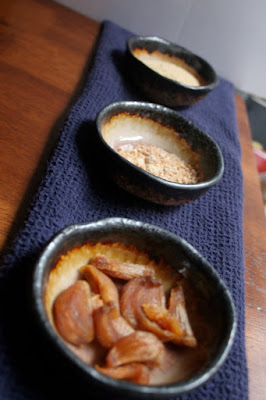Raw vs. Molecular Gastronomy
Yah, I know. Two things wrong with the title. First, most people who fall under the category MG, hate the phrase. Second, isn't it oxymoronic? I mean, Raw Veganism is hippie rabbit food. A diet already restricted by veganism compounded with the inability to heat anything past 104 °F (40 °C) to 115 °F (46 °C). Salads and juices, oh my!
Contrast that with the Modernists, Molecular Chefs, Molecular Gastronomers, what ever they want to be called often cook with ingredients whose usage was pioneered in the industrial food industry. Kitchens like laboratories. Ingredients like Hydrocolloids, Transglutaminase, Tapioca Maltodextrin, and Xanthan Gum.
And first glance these forms of cuisine seem to have nothing in common. New Age Hippies vs. the Avante Garde. Let's dig into some similarities:
Don't forget to vote.
 |  |
Contrast that with the Modernists, Molecular Chefs, Molecular Gastronomers, what ever they want to be called often cook with ingredients whose usage was pioneered in the industrial food industry. Kitchens like laboratories. Ingredients like Hydrocolloids, Transglutaminase, Tapioca Maltodextrin, and Xanthan Gum.
And first glance these forms of cuisine seem to have nothing in common. New Age Hippies vs. the Avante Garde. Let's dig into some similarities:
- Creativity. I think creativity comes from two places: constriction or freedom. Modernism frees you. New textures, new techniques, new, new new. Raw constricts you. Trying to consistently prepare interesting meals when you can't use meat, dairy, and, oh I dunno... your fucking oven, is hard. That constriction led to a lot of innovation. I could go on all day about them, but what you should really do is pick up a copy of Charlie Trotter's and Roxanne Klein's Raw, and have your mind twisted.
- Polarizing. Both styles of cooking took a lot of heat for being different and bucking mainstream traditions. Don't get me wrong, I do think that Modernism will absolutely have a bigger impact on the culinary world than raw will. But, people definitely try to throw the baby out with the bathwater on both.
- Equipment. Pop quiz time: Is this following a raw or modernist kitchen:
The kitchen at _______ is filled with high-tech gadgets like dehydrators, carefully calibrated warming ovens, frothers, high-speed Vita-Mix blenders, finely honed slicers and $3,000 Pacojet frozen-food churners. There's an industrial hydraulic juicer that presses fruits and vegetables without breaking the cell walls, as juicers usually do; the extracted juices never separate.
Turns out it's a raw kitchen. Coming from a vegetarian perspective, I had the strangest sense of deja vous when I was researching MG for the first time. Champion juicers, Excalibur Dehydrators, and Vita-Prep Vita-Mix high speed blenders are likely to be found in both kitchens. - Hydrocolloids. This one will melt your head. Raw foods desserts occasionally contain Chia Seeds (Ch-ch-ch-chia!) or utilize the natural pectin in blueberries to gel desserts. Modernists obviously use hydrocolloids like Gellan, Xanthan Gum, Methyl Cellulose and Pectin.
- Patents! It is pretty well-known that Homaro Cantu has filed a number of patents.

While researching this blog post I found a raw foods patent that covers:A method of agglutinating a raw food selected from the group consisting of fruits, vegetables, sprouted grains, unsprouted grains, sweet syrups, honey, and vegetable powders, said method being carried out in a preparation area with a predetermined relative humidity, which method
comprises...
Don't forget to vote.



Great and humor riddled post - I became a vegan chef because of what appears to be a lack of ingredients, where as I found that scarcity provides clarity.
ReplyDeletehttp://knifestylesofthefitandfabulous.blogspot.com